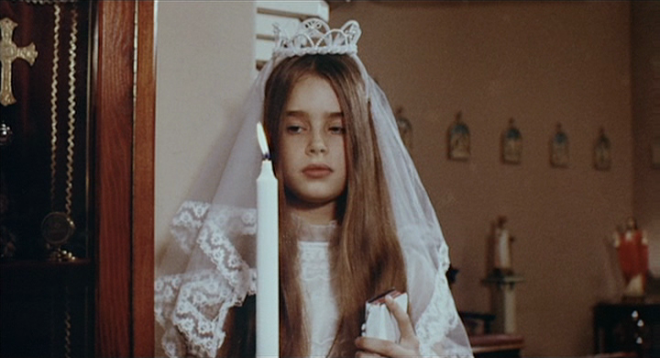Alice, Sweet Alice (1976)
It’s alarming honestly how charming she can be
The bridge between childhood and adulthood is executed in a horrifying manner in this film, cleverly visualising the terror and psychological trauma of growing up. The film contrasts the virtuous, innocent child – Brooke Shields’ Karen – with the demonic and disturbed Alice, a girl just entering her menstruation cycle for the first time.
The death of Karen towards the start of the film captures the idea of the end of innocence and purity in replacement of a poisonous contamination. With the murder scene taking place during a communion and thus before God’s eyes, the film exemplifies a blur between the spiritual afterlife worlds of Heaven and Hell. It is a story that questions morality and the double-lives of humankind. ‘Inner demons’ appear to live within all of the adult characters; their burdening and dangerous secrets hanging ominously over their lives.

The line ‘children pay for the sins of the parents’ weighs deeply upon the plot becoming a motif for the story. A number of sins are depicted from murder to fornication and licentiousness, to dishonesty and chicanery, to gluttony. These sins all take place within the home and church – around children – which depicts the terrifying corruption of cleanliness and youth within the supposed safety of the ‘familiar’. The visual emblems of dolls, crucifixes and angels as nursery room images are pitted alongside the sins, disturbing the innocent with the evil. The home is a place that is at once threatened by these evil forces with the heads of dolls being torn off and crucifixes dethroned symbolising putrefaction. Unable to escape from these immoralities, the film hints at this deterioration as being inevitable, like a spreading disease waiting to unleash it’s infection upon the fresh and pure minds of children.
The mask acts as a visual and metaphorical disguise which attempts to hide mankind’s ‘inner demons’ from the knowing world. Both Alice and Mrs Tredoni wear the mask and partake in violent acts of satanic devilishness showing the way a mind progresses and unleashes this ‘monster’ within everyone. Alice walks away at the end of the film whilst Mrs Tredoni is arrested showing that a new legacy begins where another ends; completing the eternal cycle of Hell. Ultimately the film shows the nightmarish progressive infiltration of this demon within Alice. Whilst innocence is forgotten and destroyed, evil conquers and prospers.
What inspired me: The nightmarish psychological analogy of mankind as having an innately good and innately evil part to their soul. Prompted me to pursue similar critical theories and articles.
Originally published 2nd December 2012
